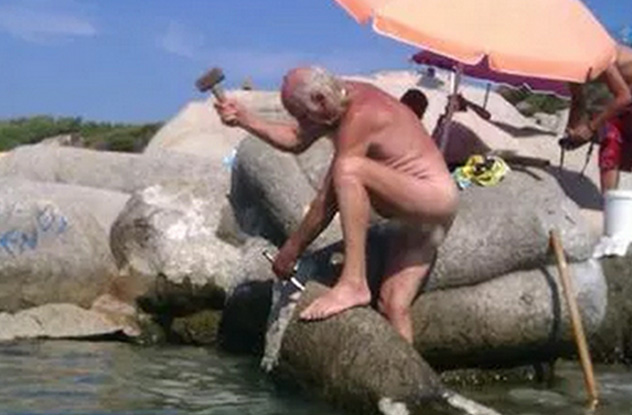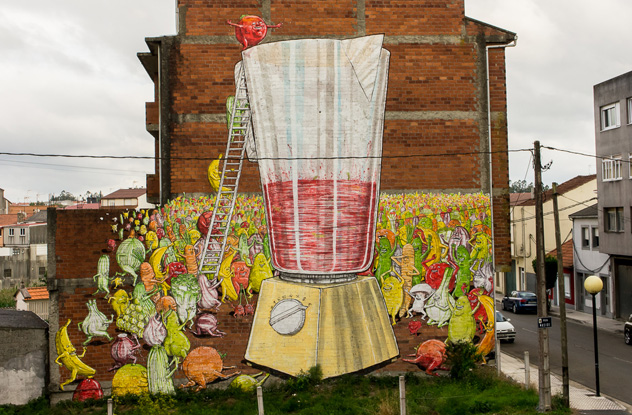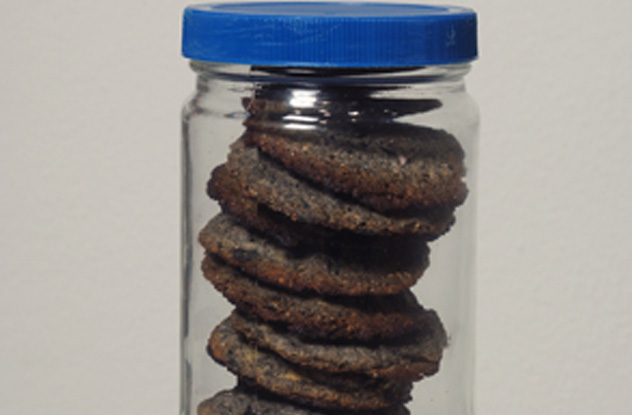10Dionysis Karipidis
In 1997, Dionysis Karipidis carved a statue of a mermaid into the rocks of Portokali beach in Greece. His larger-than-life work should have withstood the tides for centuries, but those who go to look at it now will not find it in anything like its former glory. The trouble began when the artist was issued a €522 fine relating to the statue. It seems that the work of art was actually a destruction of the local landscape, since it was carved from the rocks already there and not brought in. Several letters went between the artist and the local government, attempts were made to cancel or pay the fine on the artist’s behalf, but in the end, the artist took matters into his own hands. Matters, and a sledge hammer. Karipidis stripped himself naked and battered the mermaid, shattering her face, to protest against the fine and returning the beach to its natural state.
9Gerhard Richter
Big name artists are like economic magicians: They can make millions out of a thin layer of paint. All they have to do is let someone buy them. Gerhard Richter is a German artist who has produced works in paint, photography, and glass. In 2015, his painting Abstraktes Bild sold for $46.3 million, a record for a living artist. It’s surprising then that many of his early work, of which we have photos, have disappeared. In the 1960s, Richter took a box cutter to some of his finished paintings. Others, he burned with the rest of the rubbish from his studio. Today, those works would be worth well over half a billion dollars. Why did he do it? He simply was not happy with how they turned out. He regrets his decisions, saying, “Sometimes, when I see one of the photos, I think to myself: That’s too bad; you could have let this one or that one survive.” But he also describes the act of destruction as “liberating.”
8Blu
Street art tends to be impermanent. Being done in public and on property the artist does not own leaves it open to threats not usually faced by paintings in galleries. There is a whole Wikipedia page dedicated to destroyed Banksy works. For 20 years, the artist Blu has been painting walls in Bologna. The artist objected to his murals being removed from their locations. Not that they were to be destroyed to be destroyed, but that they were to be preserved. The city was going to take his works and place them in a gallery. Blu said, “This exhibition will embellish and legitimize the hoarding of art taken off the street, which is only going to please unscrupled collectors and merchants.” He took a chisel and some grey paint and systematically eradicated two decades of art. Blu has form when it comes to auto-destruction of his work. In 2014, he painted over one of his murals in Berlin to protest urban development.
7Charles Camoin
Many artists find it hard to get rid of any of their works. Charles Camoin has the rare distinction of having destroyed the same works of art twice. After a successful show of his paintings in 1913, Camoin suffered a serious depressive episode. He slashed over 80 of his paintings and discarded the tattered remains. A sad event, and for most artists, that would be the end of the matter. At some point, though, the paintings were recovered by the writer Francis Caro, who had them restored. When Caro later put the paintings up for auction, Camoin sued him. Camoin won the case. The court ordered the paintings to be destroyed for the second and final time.
6Jasper Johns
All artists’ work evolves over time. Sometimes, this is a radical change; sometimes it is just a tweaking of technique. What happens when an artist comes to hate the work of their younger self? Jasper Johns had an epiphany in 1954. He “decided to stop becoming and to be an artist.” He took all the art that he had created until that moment and completely destroyed it. Unlike other artists who have done something like this with some of their art, there is practically nothing remaining of Johns’ early work, not even photos. It is as if Johns stepped fully formed into the art world with his famous Flag.
5Karlis Rekevics
If you want your art to reach the future safe and sound, sculpture would seem to be the way to go. Rekevics does not seem to want his to survive. Rekevics makes his monumental artworks from tons of plaster, wood, and foam. At the end of an exhibition, he simply takes his works apart with a hammer and puts them in a dumpster. His background is as a set designer for the stage, where all works are ephemeral. Rekevics acknowledges that his destructive tendencies may cause a problem should anyone decide to buy something from one of his shows.
4Francis Bacon
Francis Bacon’s paintings are among the most expensive in the world. In fact in 2013, a triptych by Bacon sold for $142 million, making it the most expensive work of art at the time. In 1942 Bacon destroyed most of his early work. But this was not a one-off event. Throughout his career, Bacon would hack sections out of canvases he did not think were good enough but also ones he thought should have been great but which he had ruined. “I think I tend to destroy the better paintings,” he said. “I try and take them further, and they lose all their qualities.” When Bacon’s studio was inventoried after his death 100 slashed paintings were found. The destruction of the canvases is not the end of the story. Such is the hunger for Bacon’s work that even the cuttings from his destroyed paintings sell for thousands of pounds.
3John Baldessari
Sometimes in art, creation can come from destruction. John Baldessari spent the summer of 1970 destroying 13 years of paintings to create a new work, literally from the ashes. Cremation Project was the result. The artist took his back catalog of paintings to his local crematorium and reduced them to black ash. He took photos of the process, which formed part of his new work, but he also used the ash. He placed the remains in an urn and placed a plaque on it with his name and the dates the work came from. Was this a whimsical work of a deranged artist? Strangely, a practical decision may have led to Baldessari’s most famous work. In 1970, he was going to relocate and he would have had to transport all of his old work.
2Monet
Monet’s water lily paintings are a series of works done over many years in the water garden of his home. They routinely sell for tens of millions of dollars and can be found in museums around the world. But they were not universally loved in the artist’s own life time. Critics found the washy Impressionism muddy and confused. Indeed, the name “Impressionism” came from an insult levelled at Monet’s work. It is possible that the critics got to him. Just before a major exhibition of his water lily paintings in 1908, he destroyed 15 large canvases. But Monet also had a desire to control how his works would be seen by future generations. Just before his death, Monet enlisted his daughter-in-law in getting rid of 60 further paintings.
1Michelangelo
Michelangelo’s Pieta, a statue of the Virgin Mary cradling the dead Christ, is one of the masterpieces of the Vatican collection. In 1972, a mentally ill geologist attacked it with a hammer, breaking off the Virgin’s nose (which was stolen by onlookers). But this is not the work of art we are discussing. Michelangelo also created another Pieta, called The Deposition. He worked on it, according to his biographer Vasari, as a way of keeping his body and mind in order. He worked on the sculpture of four figures for eight years. And then one day, he became enraged with it, and broke it. He passed the damaged work on to a friend. Amazed at what the great man had done, he asked why it had been damaged. “He answered it was because of his servant Urbino’s importunity, who was always urging him to finish it, and besides that, among other things, he had broken a piece off the Virgin’s arm, and before that he had taken a dislike to it, having many misfortunes because of a crack there was in it; so at last, losing patience, he had broken it, and would have destroyed it altogether if his servant Antonio had not begged him to give it him as it was.” So the lesson is never to push a genius to work quickly.
























